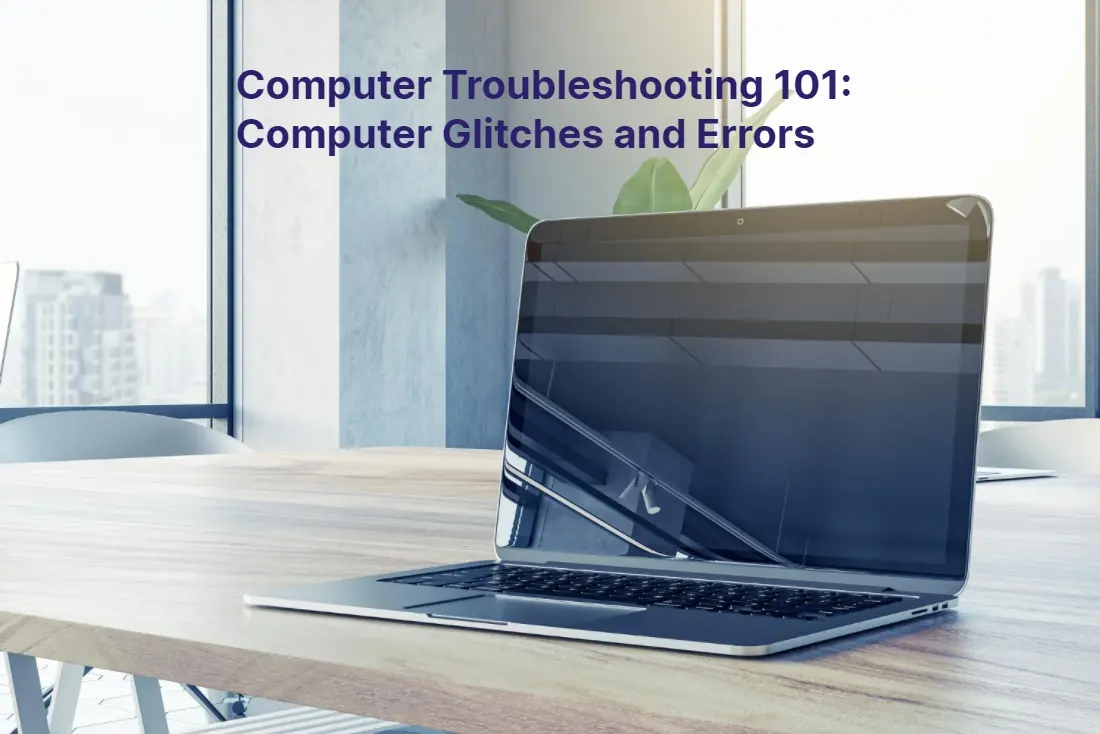
20 Jun Computer Troubleshooting 101: Unraveling the Mystery of Computer Glitches and Errors
In today’s fast-paced digital world, few things are more frustrating than encountering computer glitches and errors. Whether you’re a tech-savvy professional or a casual user, these unexpected hiccups can bring your productivity to a screeching halt. But fear not! Troubleshooting 101 is here to unravel the mystery behind these frustrating issues and guide you towards a resolution. In this comprehensive guide, we’ll delve into the common causes of computer glitches and errors, equip you with the essential knowledge to identify and troubleshoot them, and provide practical tips to prevent their recurrence. From the dreaded blue screen of death to mysterious error codes, we’ll demystify these enigmatic problems and empower you to take control of your digital devices. So, whether you’re a novice or a seasoned pro, join us on this troubleshooting journey as we conquer the world of computer glitches and errors together. Get ready to unlock the secrets of smooth computing and bid farewell to technical headaches once and for all.
Common Computer Glitches and Errors
Computer glitches and errors can manifest in a variety of ways, leaving users puzzled and frustrated. Understanding the common types of glitches and errors can help you pinpoint the root cause and find a solution. One of the most common issues is a freezing or crashing computer. This can occur due to insufficient memory, overheating, or software conflicts. Another prevalent problem is a slow-performing computer, which can be caused by malware, unnecessary startup programs, or a fragmented hard drive. Additionally, error messages such as “DLL file not found” or “Application has stopped working” can also cause confusion and hinder your workflow. By familiarizing yourself with these common issues, you’ll be better equipped to tackle them head-on and restore your computer’s functionality.
Understanding Error Messages
When your computer encounters an error, it often displays a message that provides some insight into the problem. These error messages can be cryptic and intimidating, but deciphering their meaning is crucial for effective troubleshooting. Error messages can indicate a hardware failure, a software compatibility issue, or a corrupt file. By carefully reading and understanding the error message, you can gather valuable information that will guide your troubleshooting efforts. Additionally, error codes can provide further clues about the underlying problem. A quick internet search with the error code as a keyword can often lead you to community forums or knowledge base articles that offer solutions. Remember, understanding the error message is the first step towards finding a resolution.
Are you facing the problem of a non-working computer?
Don’t worry about it – Downtown Computer Services offers free computer diagnostics and troubleshooting. You can call us at 954-524-90-02 now!
Troubleshooting Steps for Computer Glitches and Errors
When faced with a computer glitch or error, it’s important to approach the problem systematically. Following a set of troubleshooting steps can help you identify the cause and implement a solution. The first step is to reboot your computer. Many problems can be resolved by simply restarting the system, as it clears out temporary files and resets various settings. If the issue persists, the next step is to check for software updates and patches. Outdated software can cause compatibility issues and vulnerabilities that lead to glitches and errors. By keeping your operating system, drivers, and applications up to date, you can minimize the likelihood of encountering these problems.
If software updates don’t resolve the issue, it’s time to investigate hardware-related problems. Start by ensuring that all cables and connections are secure. Loose cables can disrupt the flow of data and cause errors. Next, check the hardware components for any signs of damage or malfunction. Faulty RAM modules, hard drives, or graphics cards can cause a range of issues. Running diagnostic tests or seeking professional help can help identify and rectify hardware-related problems.
Internet connectivity problems are another common source of frustration. If your internet connection is unreliable or slow, it can impact your overall computer performance. Begin troubleshooting by checking your network cables and router. Restarting your router and updating its firmware can often resolve connectivity issues. If the problem persists, contact your internet service provider for assistance.
Software Updates and Patches
Keeping your computer’s software up to date is essential for a smooth and secure computing experience. Software updates and patches
) typically include bug fixes, security enhancements, and performance improvements. By regularly checking for updates and installing them, you can prevent glitches and errors caused by outdated software. Most operating systems and applications provide automatic update options, which can simplify the process. It’s important to note that while updates are generally beneficial, occasionally, they can introduce new issues. If you encounter problems after an update, check online forums or support channels for workarounds or known conflicts.
Hardware Issues and Solutions
Hardware problems can be a significant source of computer glitches and errors. Faulty components or poorly connected hardware can cause a range of issues, from random crashes to blue screens of death. To troubleshoot hardware-related problems start by checking all physical connections. Ensure that cables are securely plugged in, and there are no loose connections. If the issue persists, test your hardware components individually. Remove any unnecessary peripherals and test your computer’s performance. If the problem disappears, it suggests that one of the peripherals is causing the issue. Gradually reconnect each peripheral until the problem reoccurs, indicating the faulty device. For more complex hardware issues, seeking professional help is recommended to avoid causing further damage.
Internet Connectivity Problems
A stable internet connection is crucial for many computer tasks, from browsing the web to accessing online services. When your internet connection is slow or unreliable, it can be frustrating and impact your productivity. To troubleshoot internet connectivity problems, begin by checking your network cables and connections. Ensure that all cables are securely plugged in and that there are no visible signs of damage. Restarting your router and modem can often solve minor connectivity issues. Updating your router’s firmware to the latest version can also improve its performance. If the problem persists, contact your internet service provider for assistance. They can perform line tests and help diagnose any issues with your connection.
Virus and Malware Removal
Viruses and malware can wreak havoc on your computer, causing glitches, errors, and even compromising your personal information. To protect your system and prevent these issues, it’s crucial to have reliable antivirus software installed. Regularly scan your computer for malware and ensure that your antivirus software is up-to-date. If your computer is already infected, perform a deep scan and follow the recommended steps to remove the malicious software. Additionally, practicing safe browsing habits, such as avoiding suspicious websites and downloading files from trusted sources, can help prevent malware infections.
Backing up Your Data to Prevent Loss
Data loss can occur due to various reasons, including hardware failures, software glitches, or accidental deletion. To mitigate the risk of losing important files, it’s essential to regularly back up your data. There are several backup options available, ranging from external hard drives to cloud storage services. Choose a backup method that suits your needs and set up automatic backups whenever possible. Regularly verify the integrity of your backups and periodically restore files to ensure they are accessible and intact. By implementing a robust backup strategy, you can minimize the impact of computer glitches and errors on your valuable data.
Seeking Professional Help for Complex Issues
While many computer glitches and errors can be resolved through troubleshooting, some issues may require professional assistance. Complex hardware failures, persistent software conflicts, or advanced malware infections may be beyond the scope of a regular user. In such cases, it’s advisable to seek help from a certified technician or IT professional. They have the expertise and tools to diagnose and resolve complex issues efficiently. Additionally, professional assistance can save you time and prevent further damage to your computer. Remember, it’s better to seek help when needed than to risk exacerbating the problem.
Conclusion
Computer glitches and errors are an unfortunate reality of our digital lives. However, armed with the knowledge and troubleshooting techniques outlined in this comprehensive guide, you can confidently tackle these technical hurdles. By understanding common computer glitches and errors, interpreting error messages, and following a systematic troubleshooting approach, you can effectively identify and resolve these issues. Regular software updates, attention to hardware connections, and practicing safe browsing habits can prevent many problems from occurring in the first place. And, by backing up your data and seeking professional help when necessary, you can safeguard your digital assets and ensure a smooth computing experience
For all of your computer troubleshooting requirements, choose Downtown Computer Services
In our repair shop, our computer repair technician is prepared to carry out free computer diagnostics and repairs. Call us right away at (954) 524 9002 or fill out the form below to request a repair.
Check out other relevant news
- How Easy-to-Use Hacking Tools Are Fueling Cybercrime
- Cryptocurrency Security for Small Businesses: Protecting Your Wallet
- The Infostealer Epidemic: Protecting Your Business from the Latest Wave of Cyberattacks
- The Identity Crisis: How Compromised Credentials Can Cripple Your Business
- Beyond the Brick and Mortar: Building Your Online Storefront with Digital Marketing
